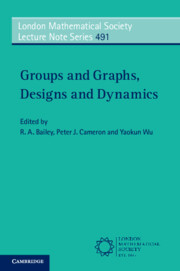1 - Topics in representation theory of finite groups
Published online by Cambridge University Press: 11 May 2024
Summary
This is an introduction to representation theory and harmonic analysis on finite groups. This includes, in particular, Gelfand pairs (with applications to diffusion processes à la Diaconis) and induced representations (focusing on the little group method of Mackey and Wigner). We also discuss Laplace operators and spectral theory of finite regular graphs. In the last part, we present the representation theory of GL(2, Fq), the general linear group of invertible 2 × 2 matrices with coefficients in a finite field with q elements. More precisely, we revisit the classical Gelfand–Graev representation of GL(2, Fq) in terms of the so-called multiplicity-free triples and their associated Hecke algebras. The presentation is not fully self-contained: most of the basic and elementary facts are proved in detail, some others are left as exercises, while, for more advanced results with no proof, precise references are provided.
Keywords
Information
- Type
- Chapter
- Information
- Groups and Graphs, Designs and Dynamics , pp. 1 - 86Publisher: Cambridge University PressPrint publication year: 2024
